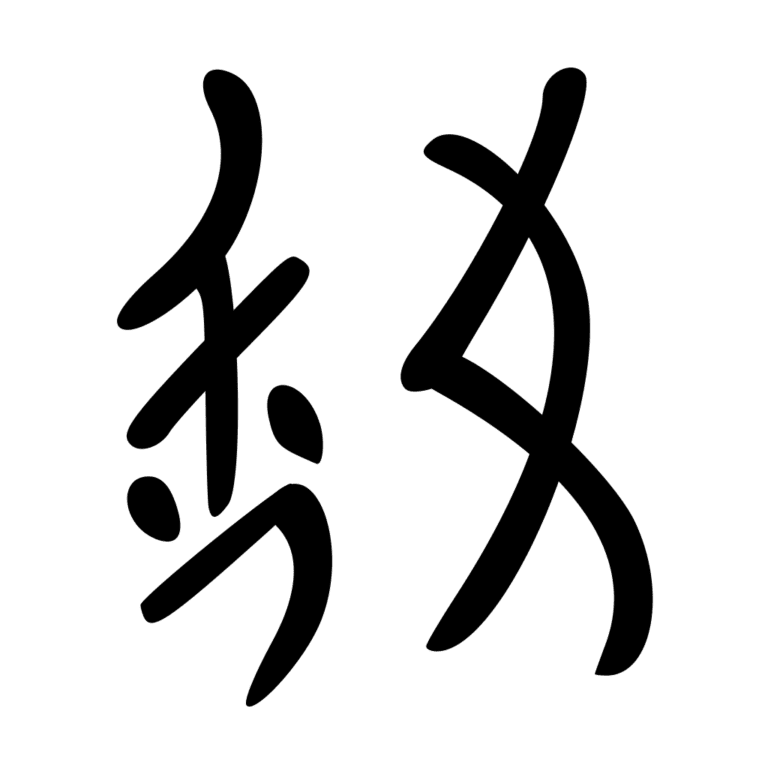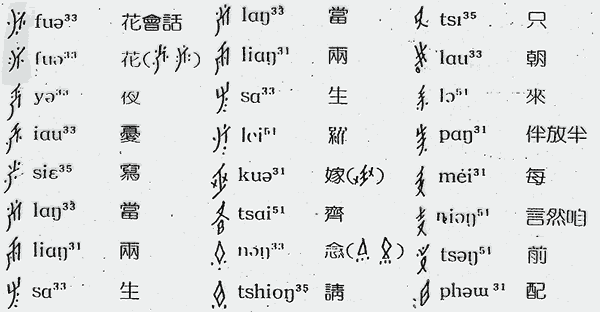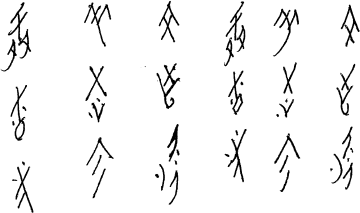In Jiangyong county of Hunan province of China, there is an ancient script. It is related to Hanzi, that was designed to put into writing the local Tuhua dialect.
However, Hanzi is a pictographic, character-based writing system that is attested from at least the year 1600 BC. This system of writing dates back no further than the high Middle Ages.
It is much also more phonetic in nature. The script contains no more than a few hundred characters.
Like most of the world’s writing systems, it was devised at a time when literacy was rare among the common folk, and even among the elites was dominated by men.
Nüshu writing, however, was developed by women, read exclusively by women. It was not even known to most men until the 20th century.
A selection of Nüshu characters and their Chinese equivalents
How it works
Anyone familiar with the development of the Japanese Katakana will recognize Nüshu’s origin story. In the system of Nüshu, each character is based on a Hanzi character with a similar pronunciation.
For example, the character 生 (birth or life), which is pronounced “sa” in Tuhua, came to stand in for any occurrence of the syllable “sa”, regardless of meaning. There was not necessarily any meaning tied to the character the way there is in modern Hanzi.
That said, there were a few hundred very common words that were pictographic in nature. But anything beyond that was expressed with the alphabet.
A good comparison is the way some English sentences can be expressed entirely through emoji. When you need to text a more complicated idea, you have to fall back on the alphabet.
But you could in theory say quite a bit through nothing more than emoji, many of which don’t even have a “pronunciation”, per se.
There are also two other quirks of Nüshu. One, although its characters are indeed based on Hanzi, they are very much simplified and written with an almost italicized appearance. This can sometimes render them barely recognizable.
Two, the script is written from right to left, just like Arabic or Hebrew.
This written script was passed down from mother to daughter over the course of several hundred years. This worked just as skills such as sewing and cooking were.
Incidentally, the script was not most often written with ink and paper, but sewn into quilts and embroidery.
Often it told a story that would go on to be remembered through such script. That said, there are examples of poetry and written stories.
Nüshu and Hanzi side by side
Laotong - sworn sisterhood
In Jiangyong County, there is a concept known as “sworn sisterhood”, or Laotong. This is vaguely akin to marriage, but instead of a man and a woman, it’s two women, and they form more of a sister-like relationship.
One common way Laotong were formed would in fact come from plans for an arranged marriage. Two sets of parents might agree to marry their respective children to each other, possibly before the children had been born.
Should they both have been girls, then they would commonly make the girls a Laotong. Usually, both would still go on to be married with other people. Still, they would maintain contact with each other over the years, just like biological sisters might.
Thus, they would have written to each other in Nüshu, the only form of literacy they would have understood. Interestingly, the adjacent men knew nothing about it, nor did they particularly care.
In most cases, the men would look at these embroideries and see nothing more than a fancy design, totally unaware that it was actually a secret writing system that the women were using to communicate.
A Nüshu Poem. The above reads:
Beside a well,
one does not thirst.
Beside a sister,
one does not despair.
The Death of Nüshu
All things come to an end, and Nüshu was not an exception. Although there are to this day people who are familiar with the script, they have mainly learned it as formal students of linguistics or anthropology.
The last “true” Nüshu writer, i.e. the last woman who had learned it informally from her own mother, died in 2004.
The overwhelming reason for this was the modernization of China. Ironically, it was the strengthening in the status of women that killed the script.
After the end of the Second World War, China began a period of economic reform and modernization. Into the 1980s (the same time Nüshu became recognized among scholars), women began to join education and the workforce.
Now, there has been a sharp decline in the passing on of this interesting and quaint literary art.
This, compounded by objectively good developments, such as the massive expansion of female literacy in modern China, has rendered Nüshu largely obsolete.






0 Comments